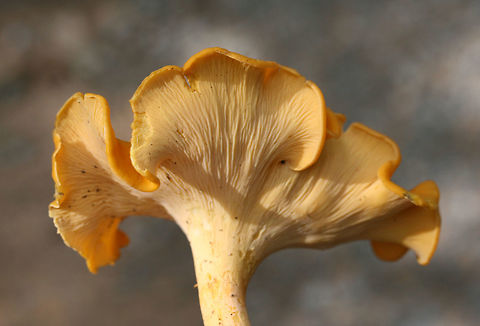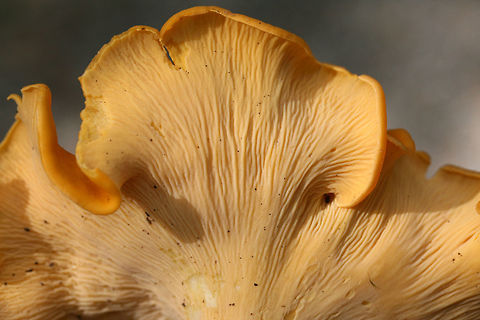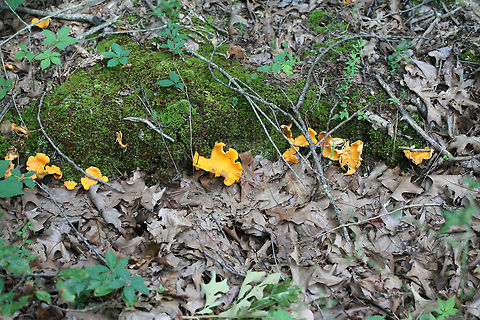
Appearance
The caps of the ''C. lateritius'' fruit bodies typically range between 2 to 9 cm in diameter, with a flattened to somewhat funnel-shaped top surface and a wavy margin. The cap surface is dry, slightly tomentose , and a deep and bright orange-yellow color, with older specimens fading to more yellow in age; the extreme margins of the cap are a paler yellow, and typically curve downward in young specimens. Fruit bodies can reach a height of 12 cm . The hymenophore is initially smooth and without wrinkles, but gradually develops channels or ridges, and what appear to be very shallow gills that are vein-like, and less than 1 mm wide. The color is pale yellow, and is continuous with the surface of the stem. The stem is rather plump and stout, 1.5 to 4.5 cm long and 0.5 to 1.7 cm thick, more or less cylindrical, tapering downwards towards the base. Internally, the stems are either stuffed or solid. Rarely, fruit bodies may be clumped together with stems joined at the base; in these cases there are usually no more than three fused stems. The flesh is solid to partly hollow , with a pale yellow color; it is 0.5 to 0.9 cm thick.The spores are smooth, with a roughly ellipsoid shape, and have typical dimensions of 7–7.5 by 4.5–5 µm. In deposit, such as in a spore print, the spores are light yellow orange, while under the microscope they are a very pale yellowish. The spore bearing cells—the basidia—are 75–80 by 7–9 µm, 4-5-6-spored, slightly club-shaped, and with a distinctly thickened wall at the base. Clamp connections are present in the hyphae of all parts of the fruit body.

Naming
''Cantharellus lateritius'' is pinker than the golden chanterelle , and has thicker flesh in addition to the smoother hymenial surface. ''C. odoratus'' is also similar in appearance, and is distinguished by a thinner flesh and a hollow stem. The poisonous "Jack O'Lantern" mushroom, ''Omphalotus olearius'', is roughly similar in stature and color, but can be differentiated from ''C. lateritius'' by its true gills with sharply defined edges, and growth on decaying wood , usually in large overlapping clusters.One author considers ''Cantharellus lateritius'' to likely represent a species complex, including "all the chanterelles with a completely smooth hymenophore, sweet smell, and clamped hyphae."

Distribution
''Cantharellus lateritius'' is distributed in North America, Africa, Malaysia, and the Himalayas . In the United States, its range extends northward to Michigan and New England.Typically found growing solitary, in groups or in clusters under hardwood trees, the fungus produces fruit bodies in the summer and autumn. In the New England area of the United States, mycologist Howard Bigelow has noted it to grow on road shoulders in grass near oaks; it also has a predilection for growing on sloping creek banks. In Malaysia, it is found growing on the soil in forests, mostly under species of ''Shorea'' . ''C. lateritius'' has been reported from the Western Ghats, Kerala, India, forming ectomycorrhizal association with endemic tree species like ''Vateria indica'', ''Hopea parviflora'', ''Diospyros malabarica'', ''Myristica malabarica'' in semi-evergreen to evergreen forests.
Habitat
''Cantharellus lateritius'' is distributed in North America, Africa, Malaysia, and the Himalayas . In the United States, its range extends northward to Michigan and New England.Typically found growing solitary, in groups or in clusters under hardwood trees, the fungus produces fruit bodies in the summer and autumn. In the New England area of the United States, mycologist Howard Bigelow has noted it to grow on road shoulders in grass near oaks; it also has a predilection for growing on sloping creek banks. In Malaysia, it is found growing on the soil in forests, mostly under species of ''Shorea'' . ''C. lateritius'' has been reported from the Western Ghats, Kerala, India, forming ectomycorrhizal association with endemic tree species like ''Vateria indica'', ''Hopea parviflora'', ''Diospyros malabarica'', ''Myristica malabarica'' in semi-evergreen to evergreen forests.
References:
Some text fragments are auto parsed from Wikipedia.